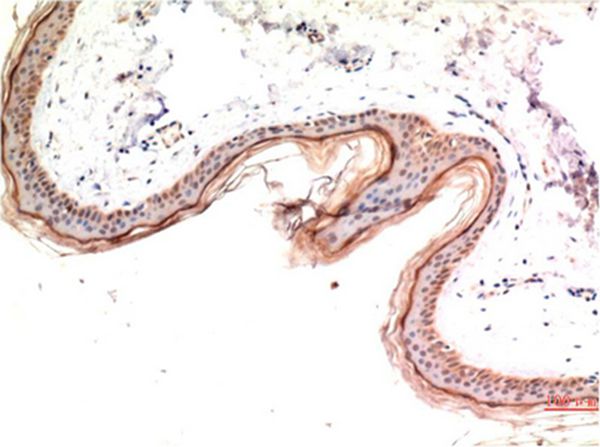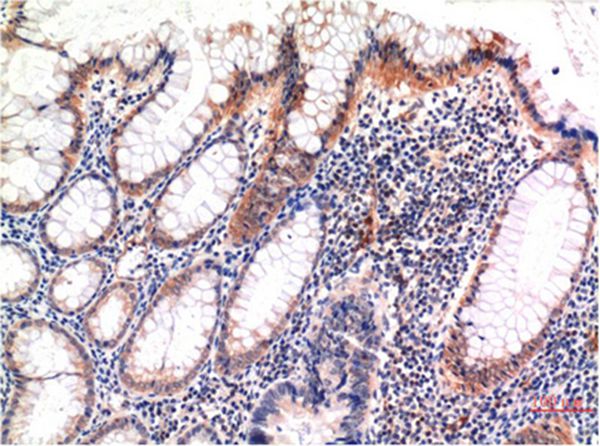

| WB | 咨询技术 | Human,Mouse,Rat |
| IF | 咨询技术 | Human,Mouse,Rat |
| IHC | 1/100-1/200 | Human,Mouse,Rat |
| ICC | 技术咨询 | Human,Mouse,Rat |
| FCM | 咨询技术 | Human,Mouse,Rat |
| Elisa | 咨询技术 | Human,Mouse,Rat |
| Aliases | MLKL |
| Entrez GeneID | 197259; |
| WB Predicted band size | 54kDa |
| Host/Isotype | Rabbit IgG |
| Antibody Type | Primary antibody |
| Storage | Store at 4°C short term. Aliquot and store at -20°C long term. Avoid freeze/thaw cycles. |
| Species Reactivity | Human |
| Immunogen | Synthetic Peptide |
| Formulation | Purified antibody in PBS with 0.05% sodium azide,0.5%BSA and 50% glycerol. |
+ +
以下是关于phospho-MLKL (S358) Mouse(6F8)抗体的3篇代表性文献概览:
---
1. **文献名称**: *MLKL forms disulfide bond-dependent amyloid-like polymers to induce necroptosis*
**作者**: Sun, L., et al.
**摘要**: 本研究通过结构生物学手段解析了MLKL在坏死性凋亡中的构象变化,利用phospho-MLKL (S358)抗体(6F8克隆)验证了人源细胞中MLKL在激活后的磷酸化状态,揭示了其通过形成淀粉样聚合物导致细胞膜破裂的机制。
---
2. **文献名称**: *Activation of the pseudokinase MLKL unleashes the four-helix bundle domain to induce membrane localization and necroptotic cell death*
**作者**: Hildebrand, J.M., et al.
**摘要**: 文章阐明了MLKL激活后四螺旋束结构域暴露的分子机制,使用6F8抗体特异性检测小鼠模型中MLKL Ser358位点的磷酸化,证实该修饰是坏死性凋亡信号传导的关键步骤。
---
3. **文献名称**: *RIPK3 deficiency or catalytically inactive RIPK1 provides greater benefit than MLKL deficiency in mouse IAV models*
**作者**: Newton, K., et al.
**摘要**: 研究比较了不同坏死性凋亡通路基因缺陷对流感病毒感染的影响,通过Western blotting结合6F8抗体检测MLKL S358磷酸化水平,证明MLKL磷酸化与病毒诱导的病理损伤直接相关。
---
**注**:以上文献可通过PubMed或期刊官网进一步检索原文。若需具体发表年份或DOI,建议结合抗体产品说明书或数据库(如CiteAb)中的引用记录进行确认。
The phospho-MLKL (S358) Mouse monoclonal antibody (clone 6F8) is a widely used tool for detecting phosphorylated mixed-lineage kinase domain-like protein (MLKL) at serine 358. a critical post-translational modification in necroptosis. MLKL is the terminal effector of the necroptotic pathway, a form of programmed cell death distinct from apoptosis. Upon activation of the pathway, receptor-interacting protein kinase 3 (RIPK3) phosphorylates MLKL at S358 (human S357), triggering MLKL oligomerization and translocation to the plasma membrane, leading to membrane permeabilization and cell death. The 6F8 antibody specifically recognizes phosphorylated S358 in mouse MLKL, making it a key reagent for studying necroptosis in murine models.
This antibody is generated in mice using hybridoma technology, with clone 6F8 demonstrating high specificity for the phosphorylated epitope. It is validated for applications including Western blotting, immunofluorescence, and immunoprecipitation. Researchers employ it to investigate necroptosis in contexts like inflammatory diseases, cancer, and neurodegenerative disorders, where dysregulated cell death pathways play a role. Its specificity is often confirmed using MLKL-deficient cells or phosphorylation-deficient mutants. By detecting active MLKL, this antibody helps elucidate the contribution of necroptosis to pathophysiology and therapeutic responses.
×